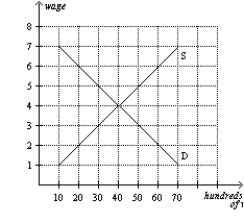Correct Answer

verified
Correct Answer
verified
Multiple Choice
Who of the following would be included in the Bureau of Labor Statistics' "unemployed" category?
A) Juan Carlos, a full-time student who is not looking for work
B) Kevin, who is on temporary layoff
C) Andrea, who has retired and is not looking for work
D) All of the above are correct.
Correct Answer

verified
Correct Answer
verified
Multiple Choice
When a union bargains successfully with employers, in that industry,
A) both the quantity of labor supplied and the quantity of labor demanded increase.
B) both the quantity of labor supplied and the quantity of labor demanded decrease.
C) the quantity of labor supplied increases and the quantity of labor demanded decreases.
D) the quantity of labor demanded increases and the quantity of labor supplied decreases.
Correct Answer

verified
Correct Answer
verified
True/False
Discouraged workers are people who want to work but have given up trying to find a job after an unsuccessful search.
Correct Answer

verified
Correct Answer
verified
Multiple Choice
According to 2012 data on the U.S. population, which of the following was correct?
A) Adults of prime working age ages 25-54) had both higher labor-force participation rates and higher rates of unemployment compared to teenagers.
B) Adults of prime working age ages 25-54) had higher labor-force participation rates and lower rates of unemployment compared to teenagers.
C) Adults of prime working age ages 25-54) had both lower labor-force participation rates and lower rates of unemployment compared to teenagers.
D) Adults of prime working age ages 25-54) had lower labor-force participation rates and higher rates of unemployment compared to teenagers.
Correct Answer

verified
Correct Answer
verified
Multiple Choice
Who among the following would be counted as "unemployed"?
A) Shasta, who is waiting to be recalled to a job from which she has been laid off.
B) Karen, who neither has a job nor is looking for one.
C) Mary, who worked only 35 hours last week.
D) None of the above is correct.
Correct Answer

verified
Correct Answer
verified
True/False
Studies have shown that the design of the unemployment insurance system reduces the job search effort of the unemployed.
Correct Answer

verified
Correct Answer
verified
Multiple Choice
Esmerelda worked parttime for her mother's business without pay. Tabitha was absent from work because she had strep throat. Who is counted as "employed" by the Bureau of Labor Statistics?
A) Esmerelda but not Tabitha
B) Tabitha but not Esmerelda
C) both Esmerelda and Tabitha
D) neither Esmerelda nor Tabitha
Correct Answer

verified
Correct Answer
verified
True/False
Most economists agree that eliminating unemployment insurance would increase the nation's overall level of wellbeing.
Correct Answer

verified
Correct Answer
verified
Multiple Choice
The Bureau of Labor Statistics reported in 2005 that there were 28.19 million people over age 25 who had no high school degree or its equivalent, 11.73 million of whom were employed and 1.04 million of whom were unemployed. What were the labor-force participation rate and the unemployment rate for this group?
A) 45.3% and 3.7%
B) 45.3% and 8.1%
C) 41.6% and 3.7%
D) 41.6% and 8.1%
Correct Answer

verified
Correct Answer
verified
True/False
Right-to-work laws give workers in a unionized firm the right to choose whether to join the union.
Correct Answer

verified
Correct Answer
verified
Multiple Choice
Since the 1940's U.S. union membership has
A) fallen. This decline should have reduced structural unemployment.
B) fallen. This decline should not have reduced structural unemployment.
C) risen. This increase should have raised structural unemployment.
D) risen. This increase should not have raised structural unemployment.
Correct Answer

verified
Correct Answer
verified
Multiple Choice
Table 28-2
Labor Data for Aridia
 -Refer to Table 28-2. The unemployment rate of Aridia in 2011 was
-Refer to Table 28-2. The unemployment rate of Aridia in 2011 was
A) 20%.
B) 31.6%.
C) 46.2%.
D) 63.3%.
Correct Answer

verified
Correct Answer
verified
Multiple Choice
Suppose that some country had an adult population of about 50 million, a labor-force participation rate of 60 percent, and an unemployment rate of 5 percent. How many people were employed?
A) 1.5 million
B) 28.5 million
C) 30 million
D) 47.5 million
Correct Answer

verified
Correct Answer
verified
Multiple Choice
Table 28-6
 -Refer to Table 28-6. What is the U-5 measure of labor underutilization?
-Refer to Table 28-6. What is the U-5 measure of labor underutilization?
A) 7.5%
B) 7.9%
C) 8.1%
D) 26%
Correct Answer

verified
Correct Answer
verified
Multiple Choice
Table 28-1
Sample Population
 -Refer to Table 28-1. How many in the sample are unemployed?
-Refer to Table 28-1. How many in the sample are unemployed?
A) 5
B) 4
C) 3
D) 2
Correct Answer

verified
Correct Answer
verified
Multiple Choice
Right-to-work laws
A) guarantee workers the right to form unions.
B) give workers in a unionized firm the right to choose whether to join the union.
C) prevent employers from hiring permanent replacements for workers who are on strike.
D) prevent workers from being fired because of increases in wages brought about by collective bargaining.
Correct Answer

verified
Correct Answer
verified
Multiple Choice
Figure 28-4  -Refer to Figure 28-4. If the government imposes a minimum wage of $5, how many workers will be unemployed?
-Refer to Figure 28-4. If the government imposes a minimum wage of $5, how many workers will be unemployed?
A) 0
B) 2,000
C) 4,000
D) 6,000
Correct Answer

verified
Correct Answer
verified
Multiple Choice
Which of the following is not a commonly-cited explanation for the decreasing labor-force participation rates for men from 1950 to the present?
A) availability of reliable birth control
B) men acquiring additional years of schooling before entering the labor force
C) a preference for men to retire when younger
D) changing social attitudes about stay-at-home fathers
Correct Answer

verified
Correct Answer
verified
True/False
The demand for labor by a certain firm is independent of the demand for that firm's product.
Correct Answer

verified
Correct Answer
verified
Showing 21 - 40 of 698
Related Exams